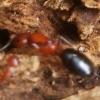My Camponotus decipiens outworld is a 20g aquarium filled with rocks (for drainage) then dirt. I am growing small plants and grasses and have roaming earth worms, isopods, and springtails. I enjoy this natural set up and much of the ant waste is simply food for the decomposers and the plants, instead of mold and fungus. This works well for the Camponotus decipiens as they will only nest in soil as a last resort, much preferring spaces already hollowed or easily hollowed that are above ground and somewhat dry. Think under bark, in dead branches, logs, and any wood already softened or hollowed by termites and insect larva. I have no worries about one day finding the queen and / or the majority of the colony hunkering down underground as it were.
Would my random stowaway Camponotus floridanus colony, once they need an actual, big outworld, behave especially different? I know these guys are going to like moisture a lot more then my C. decipiens so keeping the soil damp for the plants and isopods will not be deterrent for them, so I am thinking of just making a grout landscape in their outworld. If y'all think they will be too attracted to a clean hollowed space above ground with sawdust to clear to bother with the soil though, I'd love to make another live plant and active biosphere outworld. I wouldn't make the soil sandy like I imagine they would normally experience, so perhaps that would also make the soil nesting less likely.
I really think they might just dig though, I know when I visit my sister in Florida I see them in trees, half buried logs, under logs, and somewhat in the dirt under a build of plant detritus. They really seem to not be too picky, only preferring the hollow wood but really making due with any location they can defend against all the other types of ants out there. I'm no expert and that is a really limited observation of what was probably one huge colony they have on their property. It had several satellite nests surrounding an old dead tree filled to the brim with their colony.
Should I give the dirt outworld a try when the time comes? Who out there has some experience with Camponotus floridanus behavior?
Thank y'all.















